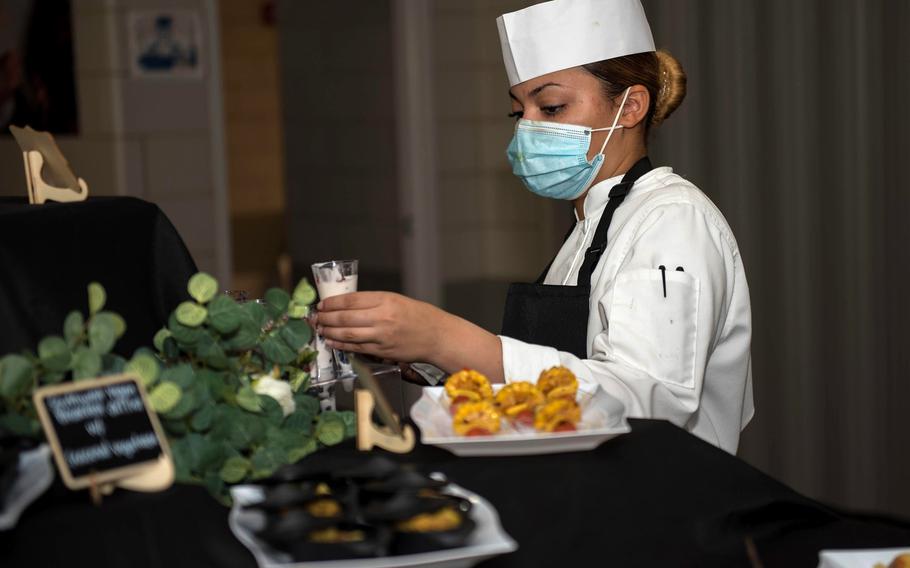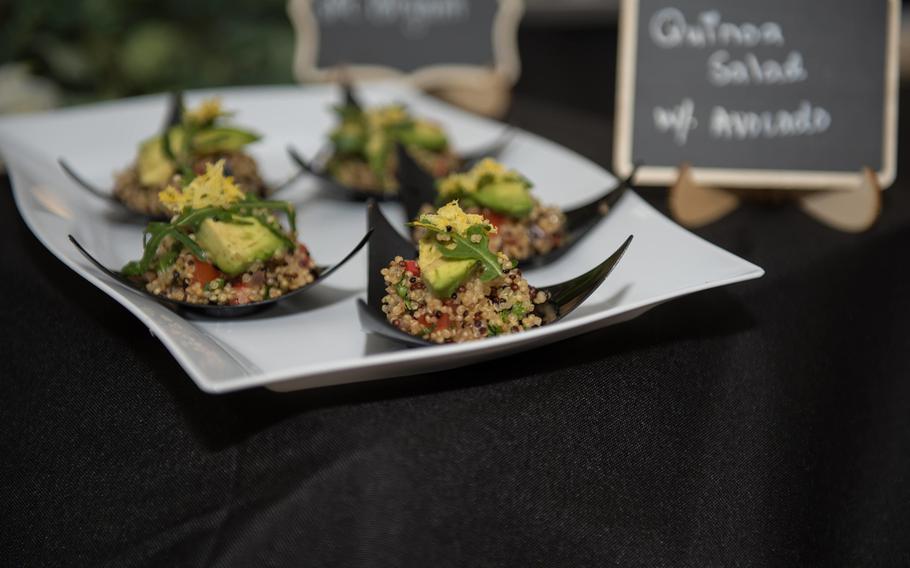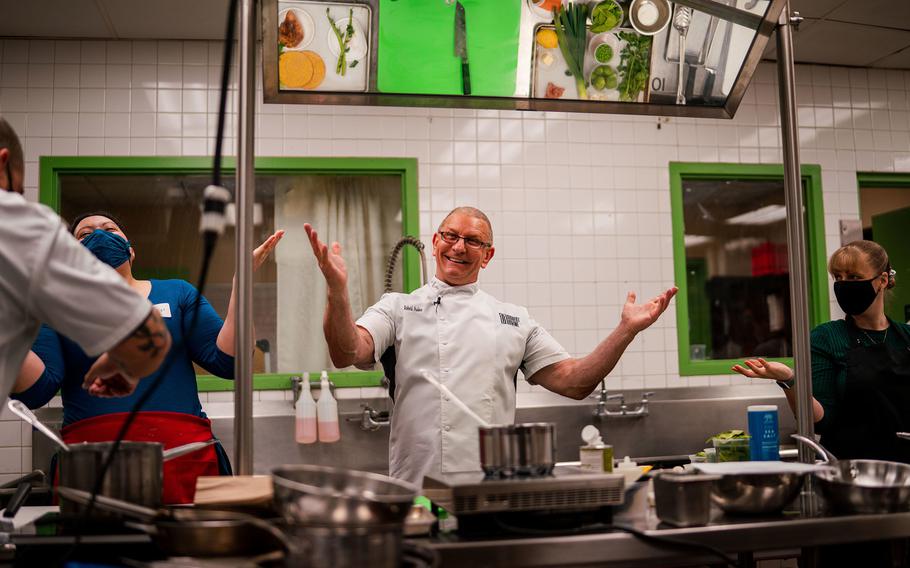Can Army Retirees Eat at Military Dining Facilities

Spc. Stephanie Bryant, 3rd Cavalry Regiment, prepares food during Taste Fest at Fort Hood, Texas, March 12, 2021. (Kelvin Ringold/U.S. Army)

Spc. Stephanie Bryant, 3rd Cavalry Regiment, prepares food during Taste Fest at Fort Hood, Texas, March 12, 2021. (Kelvin Ringold/U.S. Army)

Pfc. Christopher Vandonsel, left, and Pfc. Michael Corrales, 303rd Military Intelligence Battalion, give their opinions on the food at the inaugural Taste Fest event at the Always Ready Warrior Restaurant at Fort Hood, Texas, March 12, 2021. (Kelvin Ringold/U.S. Army)

Stuffed avocado with quinoa salad dishes wait to be sampled by guests at the Always Ready Warrior Restaurant at Fort Hood, Texas, March 12, 2021. ( Kelvin Ringold/U.S. Army)

Chef Robert Irvine engages with others at the Culinary University on Joint Base Lewis-McChord, Wash., Jan. 25, 2021. The Army recruited Irvine, a fixture at holiday USO shows downrange in recent years, to help find ways to attract younger troops to the dining facilities. (Sam Weldin/U.S. Army)

Pfc. Erica Kenmegne, a culinary specialist with 10th Mountain Division, adds the final touch to a Meal Prep to-go meal at the Commando Warrior Restaurant at Fort Drum, N.Y., Jan.11, 2021. (Jessica George/U.S. Army)
Base cafeterias will always be "chow halls" for many, while others call them DFACs. But the Army is trying to add a new term to the lexicon: warrior restaurant.
In an effort to change how and what soldiers eat, the service has begun rebranding its dining facilities, modernizing them and upgrading their offerings to prioritize fresh or frozen ingredients over heavily processed foods.
"Warrior restaurant" is the preferred nomenclature, Sgt. Maj. Ken Fauska of the Army's Joint Culinary Center of Excellence said in a statement in January. Use of the term has been percolating on social media, mostly through the facilities' official accounts and by Army leaders promoting them.
"I miss just calling it a DFAC," Command Sgt. Maj. Jason Towns said in a recent tweet. "It's still a challenge to remember to call it a Warrior Restaurant."
The dining facility overhaul comes as the Army looks to combat obesity and boost soldier fitness, and after Army and Air Force officials began exploring a university campus-style dining plan that would let soldiers use meal cards outside DFACs, at places where they've been paying out of pocket.
To lure customers, some DFACs have begun experimenting with more meatless meals, some of which were offered last week to troops at Fort Hood, Texas, during a "Taste Fest" at the Always Ready Warrior Restaurant.
After a four-day training event with a Florida-based chef, Fort Hood culinary specialists served up samples of vegan breakfast burritos with scrambled tofu, vegan spelt pancakes topped with fresh berries, stuffed avocados with quinoa salad, and pan-seared teriyaki tofu steak with couscous and grilled asparagus.
To promote healthier eating, facilities are also placing salad bars more prominently, deep-sixing deep fat fryers and switching to air frying ovens.
On social media, chow halls boast about meals with more whole grains, lean meats, fruits and vegetables — sometimes pitting them against fast food joints or other competitors.
"Don't waste your money at Burger King ... hmmmm!" said a recent 3rd Infantry Division Food Service post on Facebook with photos of fruits, vegetables and what looked like baked fish filet.
DFAC meals are subsidized through food allowances, which let soldiers who live in the barracks use meal cards to pay for breakfast, lunch and dinner. But many soldiers fail to use about half that entitlement.
That means each soldier leaves about $170 a month "on the table," partly because of difficulty getting to DFACs at meal times for various reasons, Rep. Tim Ryan, D-Ohio, said during a committee hearing last year.
There is a "lack of participation in large volumes in the chow halls," former Army Secretary Ryan McCarthy told lawmakers at the hearing.
Soldiers know about them, but "the million-dollar question" is how to get them eating there, said Chief Warrant Officer 3 Michael Barnes, a food service adviser at Fort Polk, La.
While some DFACs have been stressing their value and menu variety, bases are also launching food trucks, in-barracks kiosks and late-night or extended meal times to better serve the troops.
Sgt. Maj. of the Army Michael Grinston touted the "transition to the warrior restaurant" at the Association of the U.S. Army's annual meeting and expo in October, saying the mess hall makeover aims to create "someplace you'd be proud to eat with your squad."
They're adding ID card scanners to cut down on wait times, starting to allow credit card payments and working to improve the food quality.
Installations are partnering with chefs off-base to improve kitchen staff mentorship and training. The service has recruited Food Network chef Robert Irvine, a fixture at holiday USO shows downrange in recent years, to help find ways to attract younger troops to the DFACs.
"If you give soldiers what they want, they will eat there," Irvine said in August.
But will anyone really call them by the new name, especially without a catchy military acronym? Last weekend, U.S. Army WTF Moments posted a variation of the "woman yelling at cat" meme depicting the renaming struggle.
"Warrior Restaurant? WTF!" retired Army Brig. Gen. Bill Shea wrote in response. "It's a Chow Hall!"
garland.chad@stripes.com Twitter: @chadgarland

Chad Garland
Chad is a Marine Corps veteran who covers the U.S. military in the Middle East, Afghanistan and sometimes elsewhere for Stars and Stripes. An Illinois native who's reported for news outlets in Washington, D.C., Arizona, Oregon and California, he's an alumnus of the Defense Language Institute, the University of Illinois at Urbana-Champaign and Arizona State University.
Can Army Retirees Eat at Military Dining Facilities
Source: https://www.stripes.com/branches/army/warrior-restaurants-how-the-army-hopes-to-boost-dfac-usage-1.666269



